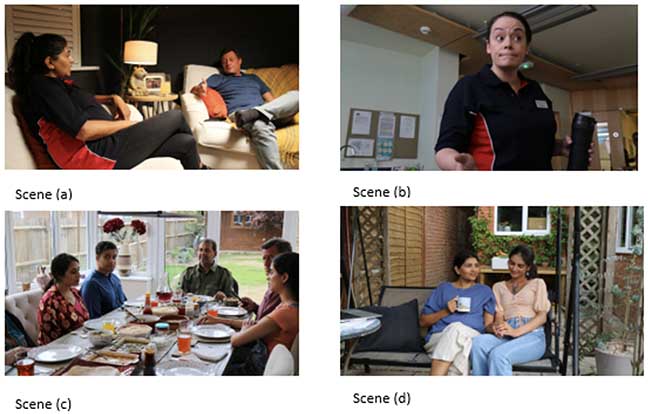
Volume 25, Number 1
Philippa Waterhouse1 and Naomi Moller2
1School of Health, Wellbeing and Social Care, The Open University; 2School of Psychology and Counselling, The Open University
As labour markets undergo rapid and profound transformations, lifelong learning is essential to ensure a responsive, competitive, and skilled workforce. Mature learners are a diverse group, but in comparison to their younger student counterparts, are more likely to have employment and/or caring responsibilities. This field note discusses the development and features of a novel online open educational resource, called At a crossroads: Navigating work and/or family alongside study (At a crossroads for brevity). The resource aimed to assist university students to both learn about the support options available to them as well as to consider how they themselves might make decisions if they experienced a conflict between their student/work/family roles. At a crossroads is innovative in terms of how it was developed (i.e., via survey-based research, story completion method, and consultations sessions with tertiary students) and in terms of what it is (i.e., an online interactive resource that incorporates short dramatizations, social polls, and opportunities to reflect). Our experience in developing this resource caused us to consider how making resources designed to be engaging and informative, while encouraging, positive changes, must be part of the solution. This is especially so when there is significant concern around the overall well-being of tertiary students and their course completion rates. While universities have attempted to offer a range of tools to support their students, on-demand online resources such as At a crossroads are easily accessed, free to use, and deliver content in an engaging manner.
Keywords: open education resource, work-family-study, mental well-being, higher education
As labour markets undergo rapid and profound transformations, lifelong learning is essential to ensure a responsive, competitive, and skilled workforce. Since 2001, lifelong learning has been a key commitment for higher education institutions in Europe through the Bologna Process (Jakobi & Rusconi, 2009). Additionally, lifelong learning as a priority has been articulated through Goal 4 of the United Nation’s Sustainable Development Goals to “ensure inclusive and equitable quality education and promote lifelong learning opportunities for all” (United Nations, 2023, para. 1). Adult or mature learners, commonly defined as aged 25 years and older (Lodewyck, 2021), make up a substantial proportion of students in higher education. For example, they formed 34.9% of tertiary students in the 27 European Union countries in 2020 (Eurostat, 2022), 38.2% of higher education students in Australia in 2021 (Australian Government Department of Education, 2023), and 33.4% of college students in the USA in 2020 (Hanson, 2024).
Mature learners are a diverse group, but compared to their younger student counterparts, are more likely to have employment and/or caring responsibilities (Social Research and Demonstration Corporation, 2020). The possible difficulties in combining university study with paid work and/or family have been well documented in the literature. The concept of role conflict, the perceived incompatibility among roles (Greenhaus & Beutell, 1985), has been drawn upon to understand students’ experiences. For example, Hammer et al.’s (1998) quantitative analysis of survey responses from 375 undergraduates at a university in the United States found that the number of dependent children of participants was associated with greater perceived conflict between family and study, and the average hours of paid work was associated with greater perceived conflict between work and study. Creed’s et al. (2022) analysis of mature-age students in Australia found that congruence, or boundary management, between work and study roles was associated with reduced perceived conflict between these roles. Students’ work and family commitments have also been linked to outcomes such as increased attrition (Moore & Greenland 2017; Morison & Cowley, 2017), compromised mental well-being (Giancola et al., 2009; Nicklin et al., 2019; Waterhouse et al., 2020) and lower student satisfaction (Waterhouse et al. 2022).
Mature learners are more likely to be studying part-time, at a distance, or be commuter students. These study modes are associated with different levels of engagement with the campus environment for these students, which in turn can result in them having difficulties accessing support. This article discusses the development of a novel online open educational resource that aimed to support students who work and/or have family responsibilities to successfully manage their studies. The resource was innovative both in terms of how it was developed (i.e., from research and through co-creation) and in terms of what it is—an interactive resource that incorporated short films, social polls, and opportunities to reflect. Called At a crossroads: Navigating work and/or family alongside study, the open educational resource aimed to support university students to both learn about the support options available to them and to consider how they themselves might make decisions, if they experience a conflict among their student/work/family roles. The development of this resource was part of a larger project called Positive Digital Practices, a collaboration involving three UK higher education institutions (The UK Open University, The University of Warwick, and The University of Bradford) and three UK sector bodies (Jisc, Student Minds, and the University Mental Health Advisory Network). The project aimed to embed and sustain positive practices that support mental well-being in higher education.
The At a crossroads resource centred on an engaging dramatization, using professional actors, that followed Jaya, a university student, as she struggled to finish her latest assignment on time. Jaya was studying part-time whilst also in paid employment. She lived with her husband and teenage daughter. We deliberately avoided specifying whether Jaya was studying at a conventional campus-based institution or via distance education to ensure the relevance of the interactive resource to a wide audience.
The dramatization followed Jaya’s journey over three days as she navigated her work, family, and studies. The film was split into four segments depicting: (a) tensions between Jaya and her wider family after she was late for a family gathering; (b) a lack of support from her employer, who pressured her into working overtime; (c) a perceived lack of support from her partner; and (d) a culminating final scene where Jaya contemplated dropping out of university. Figure 1 illustrates a scene from each of these segments. The interactive resource itself was organized into four segments corresponding to the points or issues raised in the short film. On the main menu, students can choose to follow the interactive sequentially, or skip to any of the four segments.
Figure 1
Clips From Each of the Four Segments of the Dramatization

From “At a crossroads: navigating work and/or family alongside study” by OpenLearn, The Open University, 2023 (https://www.open.edu/openlearn/crossroads). Reprinted with permission.
After each segment of the dramatization, reflective questions were presented to encourage users to consider some of the challenges experienced by Jaya in the film (Figure 2). Each segment also contained a section (labelled In their shoes) in which users were able to select a character from the scene to get further thoughts on the situation they just watched (Figure 3 and Figure 4). The aim of this design feature was to help illustrate to learners that in these types of conflicts, different people can have contrasting viewpoints. Lastly there was written text which signposted users to evidence-informed strategies and supports (Figure 5).
Figure 2
Example of an Interactive Reflective Question in the Resource
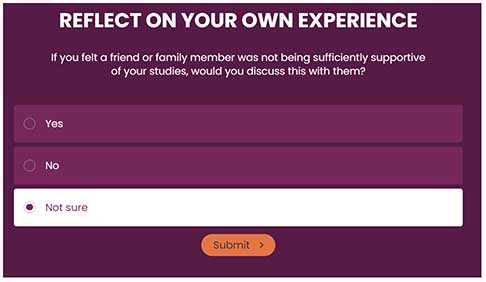
From “At a crossroads: navigating work and/or family alongside study” by OpenLearn, The Open University, 2023 (https://www.open.edu/openlearn/crossroads). Reprinted with permission.
Figure 3
Example of the In Their Shoes Section in the Resource
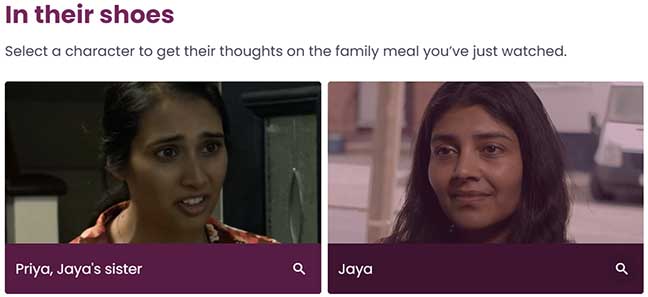
From “At a crossroads: navigating work and/or family alongside study” by OpenLearn, The Open University, 2023 (https://www.open.edu/openlearn/crossroads). Reprinted with permission.
Figure 4
Example of Written Text About one of the In Their Shoes Characters
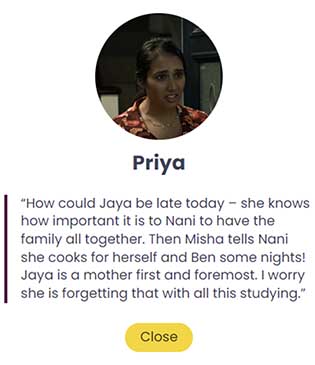
From “At a crossroads: navigating work and/or family alongside study” by OpenLearn, The Open University, 2023 (https://www.open.edu/openlearn/crossroads). Reprinted with permission.
Figure 5
Example of Written Text as Presented in the Resource
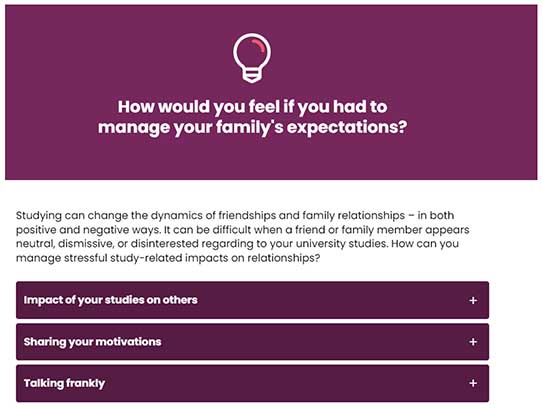
From “At a crossroads: navigating work and/or family alongside study” by OpenLearn, The Open University, 2023 (https://www.open.edu/openlearn/crossroads). Reprinted with permission.
The interactive resource ends with a section labelled Taking stock which asked users to reflect on their own experiences and encouraged them to create an action plan for their own potential role conflicts as supported by a series of prompts (Figure 6).
Figure 6
Taking Stock
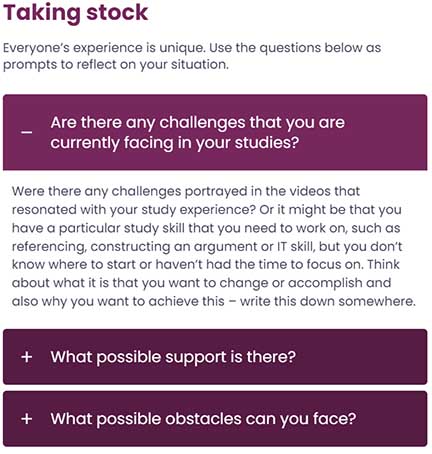
From “At a crossroads: navigating work and/or family alongside study” by OpenLearn, The Open University, 2023 (https://www.open.edu/openlearn/crossroads). Adapted with permission.
The interactive resource was informed by previous survey-based research funded by the UK Open University PRAXIS Scholarship Innovation Centre. This work explored distance education students’ (N = 348) experience of combining work and/or family responsibilities alongside their university studies. Quantitative analysis found that higher levels of reported perceived conflict among work, family, and study roles was associated with higher levels of reported mental distress (Waterhouse et al., 2020). One key recommendation from student participants was that universities should provide advice on how students could better navigate difficult study-related conversations (Samra et al., 2021). Respondents explained that there was frequently a need for them to negotiate with their family members regarding study time, and these conversations were sometimes challenging because they were often associated with feelings of guilt. Conversations with employers were also perceived as difficult. In this study students reported different strategies to manage their studies alongside additional commitments, for example pre-planning their annual leave, requesting flexible working arrangements, and organizing quality time with family members.
The development process was also shaped by the aims of the Positive Digital Practices project, which aimed to create research-informed and enduring digital resources that both embedded and sustained positive practices to support student mental health and well-being. As part of this project and to ensure the resource was evidence-informed, we conducted a qualitative story completion study and two consultations with students. The story completion method asked participants to describe what they anticipated or imagined would play out in a provided scenario about a character created for the purpose of the research (Braun et al., 2019). The following story and prompts, provided to participants, was designed to be relevant to the interactive resource.
Ali has just got the results back from the most recent assignment—and they are bad. Ali knows they didn’t study enough—too much going in their job, housework, the kids... and under pressure to do it all. There isn’t a lot of time till the next assignment deadline. What am I going to do?
Please continue the story and write about what happens. There are no limits to the scope of your story but we ask that you consider:
- What you think Ali’s thoughts and feelings might be.
- How Ali decides what to do.
- What Ali decides to do and what influences this decision.
- The outcome or consequences of any decisions Ali makes.
Story completion is a method that has gained popularity in recent years, particularly when exploring topics relating to health and well-being (e.g., Diniz et al. 2020; Lupton, 2021; Tischner 2019). Asking participants about a hypothetical situation can be a preferable method when discussing sensitive topics such as mental well-being and study challenges where students may be hesitant to discuss their own experience. In this study, 20 students provided a story that completed this stem.
The interactive resource was also informed by consultations with and feedback provided by a student panel organised by Student Minds (a charity specialising in student mental health in the UK). Due to the under-representation of Black and Asian students in the PRAXIS funded research and in the story completion research and student panel, we conducted a further consultation with Black and Asian students at The Open University (UK). The consultations explored the experiences and perceptions of students regarding the challenges that personal circumstances can place on academic study, barriers to support, and how universities could support students experiencing these role challenges better.
In the story completion research, a main theme found in the thematic analysis of the data (Braun & Clarke, 2006) was complex, strong, and difficult emotions. In stories, the main character was described as dealing with multiple negative emotions, the most common of which were anger, frustration, or disappointment with themselves, arising from a sense that they should be doing better. The next most common feeling described was panic or fear. In some cases, this stopped Ali from being able to decide what to do about their situation. Guilt was also described in a minority of stories as complicating things, making it harder for Ali to make a decision, whilst feelings of loneliness were framed as making the situation worse. In five stories, Ali questioned why they were studying. For example, whether it was worth the investment or whether it was the right time in their lives for studying. The challenges of dealing with strong negative emotions that arise in the context of study/work/family role conflict was also raised in the consultations. Participants highlighted that there was often a lack of acknowledgement by universities of this side of the student journey, and a lack of advice that support students’ with dealing with emotions connected with studying. Therefore, in creating the interactive resource we wanted experiencing, managing, and making decisions in the context of difficult negative emotions to be one of the topics of focus.
Lazarus and Folkman’s (1984) transactional model of stress, which posits stress as an outcome of the interaction between the individual and their environment, underpinned the interactive resource. Cognitive appraisal is central to this theory. Primary appraisal involves individuals evaluating a situation or environment, and if deemed stressful, secondary appraisal considers what different resources or options are available to deal with the stressor (Lazarus & Folkman, 1984). One aim of the interactive resource was to increase students’ knowledge of possible different tools or strategies to deal with demands or challenges of combining their studies with work and/or family responsibilities. The ‘taking stock’ section at the end of the interactive resource encouraged users to apply this learning to themselves.
The interactive resource was intended to encourage not only reactive coping, but also preventative and proactive coping (Reuter & Schwarzer, 2015). It was designed for use by students who perceived they were experiencing difficulties due to current study situations. It can also act as a preventative measure to help users anticipate possible future demands or challenges that they may face as well as possible actions available to try to mitigate these. Strategies suggested by the interactive resource included direct coping to try and change the situation (e.g., problem solving, time management), affect regulation strategies (e.g., dealing with emotions that arise from the study experience), and devaluation (e.g., understanding a single low assignment mark in the context of how overall degree outcomes are calculated).
Another aim of the interactive resource was to increase users’ self-efficacy (i.e., their confidence in using suggested strategies). Social learning theory (Bandura, 1977) has posited that individual self-efficacy can be influenced by vicarious experiences—people learning from observing others that are deemed to be like themselves. We, therefore, decided to use digital storytelling; evaluations have found video-based dramatizations to be a successful educational tool to bring complex topics to life (e.g., Fusco et al., 2020) and we saw this as a way of reducing psychological distance between the user and the content of the interactive. Feedback from the student panel indicated they felt emotionally connected to the characters in the dramatization, and that an outcome was that the video gave them to confidence to enact some of the different strategies highlighted in the resource.
To create the resource, we drew upon institutional expertise. OpenLearn is The UK Open University’s (OU) free learning platform. It has been providing free content, including a range of free courses and additional offerings, such as open educational resources with embedded dramatizations, since 2006. Prior to the COVID pandemic, OpenLearn had already received almost 13 million visitors (Law, 2023). However, interest in free learning grew exponentially during the pandemic, which further raised the profile of OpenLearn. For example, during the August 2019 to July 2020 period there were over 24 million visits to the platform. Given the extensive reach of OpenLearn and the opportunities this presented, we developed our resource collaboratively with the OpenLearn team and with the intention of it being hosted on this site. At a crossroads was developed in partnership with HZK Productions (for directing, filming, and editing) and Elucidat (for e-learning and technical aspects). Elucidat is a UK-based private company that specializes in commercial e-learning products and the creation of resources, using their bespoke e-learning authoring platform (Elucidat, 2023).
One challenge in making the interactive was making an individual story that could speak to a wide audience. While the stories and personal experiences shared in the consultations evidenced the range of different situations in which study/work/family role conflict is experienced, time pressures were a common theme. This led us to put together a story arc focused on Jaya struggling to complete their assignment due to time pressures. Three main sources of conflict were also identified from the research and OU consultations, namely a lack of support from (a) employers, (b) immediate family members, and (c) extended family members. These areas of conflict formed one segment each of the dramatization. The script was written by a digital media producer at The Open University (UK); filming and editing the video was undertaken by HZK Productions. The digital media producer and director were involved in discussions from inception. Key themes were discussed with them, including (a) potential variations in the level of support offered by colleagues and family members; (b) the expectations of family members and colleagues informed by gender stereotypes (e.g., family roles); (c) misconceptions and lack of understanding of university study by family and employers; (d) the importance of studying for yourself; and (e) dealing with the unexpected and the accumulative effects of demands.
Drafts of the script were reviewed, and suggested changes made by the core research team, who consisted of two academics, an associate lecturer, and student consultant. One challenge was how to end the story. The story initially ended with Jaya’s daughter encouraging Jaya to explore specific sources of support, such as the student union. However, it was felt that this ending seemed contrived. We acknowledged that there was no one best ending, as students’ situations can vary so dramatically, so it was decided to leave the film on a cliffhanger, with a crossroad moment where several alternative endings were summarized in text.
Professional actors, recruited by the director and the digital media producer, were used in the dramatization. Filming took place over two-day period at two locations—a house hired for the purpose of scenes involving the family, and several different locations at The Open University (UK) including a staff room, archive room and cafeteria space. The final film (all four segments) was 7 minutes, 16 seconds in duration.
The interactive resource was launched on OpenLearn in February 2023 through this link. The link to At the crossroads can be added to student handbooks, well-being Websites, or other student-facing resources (e.g., induction materials). We have also created a student-facing poster (Figure 7) that advertises the resource.
Figure 7
At a Crossroads: Student-Facing Poster
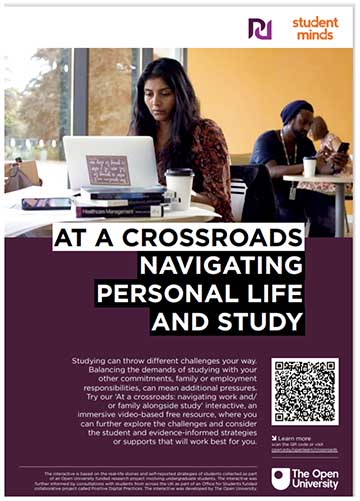
To receive digital or hard copies of this resource, please contact the lead author (philippa.waterhouse@open.ac.uk). We are currently evaluating the resource through an online survey embedded into the end of the OER as well as semi-structured interviews. In the evaluation we are particularly interested in the longer term and personal learning of students—the extent to which students do (or do not) say that engaging with the interactive has left them feeling more confident and informed in managing study/work/family role conflicts.
More broadly, our experience in developing this resource has caused us to reflect on how engaging preventative resources must be part of the solution in a context in which there is significant concern around the mental health of university students. While universities are in many cases expanding their well-being and mental health offering with additional posts to meet demand, it is critical to also consider the role of on-demand interventions that are always available, easily accessed (through an Internet-enabled device), and which consist of more than static text pages. The current resource, in our view, provides one potential model.
This work has been financially supported by The Open University Faculty of Wellbeing, Education and Language Studies PRAXIS Scholarship Centre, OpenLearn and The Office for Students [grant number DMH12]. We thank Sas Amoah (Digital Media Producer, OpenLearn), Daniel Browne (Digital Content Producer, OpenLearn), Haider Zafar (Director), Kyle Andrews (student consultant) and Christine Lyle (Associate Lecturer consultant), and Dr Mathijs Lucassen and Dr Erica Borgstorm (Open Media Fellows in the Faculty of Wellbeing, Education and Language Studies, The Open University) for their contributions in making the open education resource. We thank students who took part in the research and consultations for sharing their experiences and stories, and for providing feedback on the resource.
Australian Government Department of Education. (2023, June 19). All students by age group and broad level of course, full year 2021. https://www.education.gov.au/higher-education-statistics/resources/2021-section-2-all-students
Bandura, A. (1977). Self-efficacy: Towards a unifying theory of behavioral change. Psychological Review, 84(2), 191-215. https://doi.org/10.1037/0033-295X.84.2.191
Braun, V., & Clarke, V. (2006). Using thematic analysis in psychology. Qualitative Research in Psychology, 3(2), 77-101. https://doi.org/10.1191/1478088706qp063oa
Braun, V., Clarke, V., Frith, H., Hayfield, N., Malson, H., Moller, N., & Shah-Beckley, I. (2019). Qualitative story completion: Possibilities and possible pitfalls. Virginia Braun, Victoria Clarke, Hannah Frith, Nikki Hayfield, Helen Malson, Naomi Moller and Iduna Shah-Beckley in conversation. Qualitative Research in Psychology, 16(1), 136-155. https://doi.org/10.1080/14780887.2018.1536395
Creed, P. A., Hood, M., Bialocerkowski, A., Machin, A. M, Brough, P., Bagley, L., Winterbotham, S., & Eastgate, L. (2022). Role congruence and study engagement in mature-age students: A serial indirect effect model. Journal of Education and Work, 35(6-7), 735-750. https://doi.org/10.1080/13639080.2022.2126967
Diniz, E., Castro, P., Bousfield, A., & Bernardes, S. F. (2020). Classism and dehumanization in chronic pain: A qualitative study of nurses’ inferences about women of different socio-economic status. British Journal of Health Psychology, 25(1), 152-170. https://doi.org/10.1111/bjhp.12399
Elucidat. (2023). Our vision at Elucidat. https://www.elucidat.com/about-us/
Eurostat. (2022). Students enrolled in tertiary education by education level, programme orientation, sex and age. https://ec.europa.eu/eurostat/databrowser/view/EDUC_UOE_ENRT02__custom_5318354/default/table?lang=en
Fusco, N. M., Elze, D. E., Antonson, D. E., Jacobsen, L. J., Lyons, A. G., Symons, A. B., & Ohtake, P. J. (2020). Creating a film to teach health professions students the importance of interprofessional collaboration. American Journal of Pharmaceutical Education, 84(4), 7638. https://doi.org/10.5688/ajpe7638
Giancola, J. K., Grawitch, M. J., & Borchert, D. (2009). Dealing with the stress of college: A model for adult learners. Adult Education Quarterly, 59(3), 246-263. https://doi.org/10.1177/0741713609331479
Greenhaus, J. H., & Beutell, N. J. (1985). Sources of conflict between work and family roles. Academy of Management Review, 10(1), 76-88. https://doi.org/10.2307/258214
Hammer, L. B., Grigsby, T. D., & Woods, S. (1998). The conflicting demands of work, family and school among students at an urban university. Journal of Psychology, 132(2), 200-226. https://doi.org/10.1080/00223989809599161
Hanson, M. (2024). College enrollment and student demographic statistics. Education Data Initiative. https://educationdata.org/college-enrollment-statistics
Jakobi, A. P., & Rusconi, A. (2009). Lifelong learning in the Bologna process: European developments in higher education. Compare: A Journal of Comparative and International Education, 39(1), 51-65. https://doi.org/10.1080/03057920801936977
Law, P. (2023). Mapping the key motivations of Openlearn learners in the pandemic. In INTED2023 Proceedings (pp. 1298-1306). https://doi.org/10.21125/inted.2023.0373
Lazarus, R. S., & Folkman, S. (1984). Stress, appraisal, and coping. Springer.
Lodewyck, R. F. (2021). Postsecondary program design for adult learners. In C.L.B. Jennings (Ed.), Ensuring adult and non-traditional learners’ success with technology, design and structure (pp. 228-243). IGI-Global.
Lupton, D. (2021). ‘The internet both reassures and terrifies’: Exploring the more-than-human worlds of health information using the story completion method. Journal of Medical Humanities, 47(1), 68-77. https://dx.doi.org/10.1136/medhum-2019-011700
Moore, C., & Greenland, S. (2017). Employment-driven online student attrition and the assessment policy divide: An Australian open-access higher education perspective. Journal of Open, Flexible and Distance Learning, 21(1), 52-62. https://files.eric.ed.gov/fulltext/EJ1148193.pdf
Morison, A., & Cowley, K. (2017). An exploration of factors associated with student attrition and success in enabling programs. Issues in Educational Research, 27(2), 330-346. http://www.iier.org.au/iier27/morison.pdf
Nicklin, J. M., Meachon, E. J., & McNall, L. A. (2019). Balancing work, school and personal life among graduate students: A positive psychology approach, Applied Research in Quality of Life, 14, 1265-1286. https://doi.org/10.1007/s11482-018-9650-z
OpenLearn. (2023). At a crossroads: navigating work and/or family alongside study. Retrieved from https://www.open.edu/openlearn/crossroads
Reuter, T., & Schwarzer, R. (2015). Manage stress at work through preventive and proactive coping. In E. A. Locke (Ed.), The Blackwell handbook of principles of organisational behaviour (pp. 342-355). Blackwell Publishing.
Samra, R., Waterhouse, R., & Lucassen, M. (2021). Combining and managing work-family-study roles and perceptions of institutional support. Distance Education, 42(1), 88-105. https://doi.org/10.1080/01587919.2020.1869530
Social Research and Demonstration Corporation. (2020). Characteristics of adults who return to education: Understanding barriers to adult learning. https://srdc.org/project/characteristics-of-adults-who-return-to-education-understanding-barriers-to-adult-learning-final-report/
Tischner, I. (2019). Tomorrow is the start of the rest of their life—So who cares about health? Exploring constructions of weight-loss motivations and health using story completion. Qualitative Research in Psychology, 16(1), 54-73. https://doi.org/10.1080/14780887.2018.1536385
United Nations. (2023). Goal 4. https://sdgs.un.org/goals/goal4
Waterhouse, P., Samra, R., & Lucassen, M. (2020). Mental distress and its relationship to distance education students’ work and family roles. Distance Education, 41(4), 540-558. https://doi.org/10.1080/01587919.2020.1821606
Waterhouse, P., Samra, R., & Lucassen, M. (2022). Distance education students’ satisfaction: Do work and family roles matter? Distance Education, 43(1), 56-77. https://doi.org/10.1080/01587919.2021.2020622

Creating an Open Online Educational Resource to Support Learners as They Navigate Their Studies Alongside Work and/or Family by Philippa Waterhouse and Naomi Moller is licensed under a Creative Commons Attribution 4.0 International License.